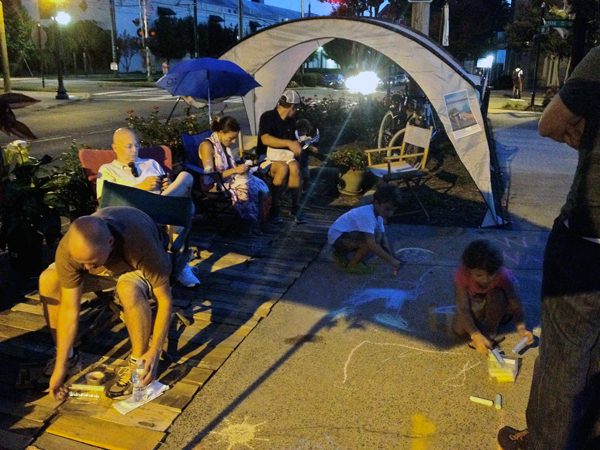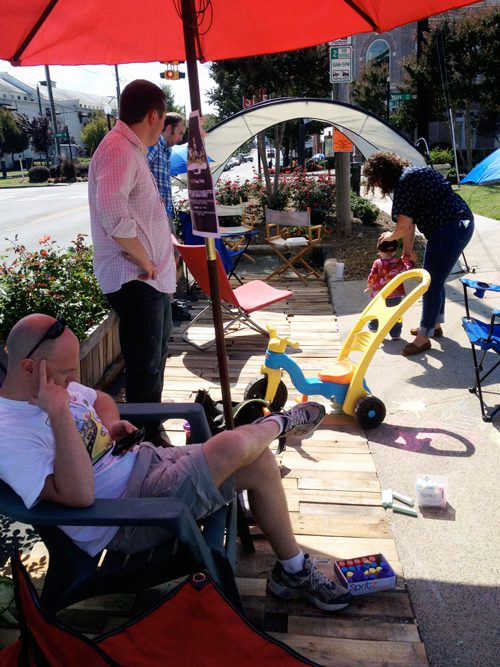Hitting the streets, with parks

So, how did it go? When I thought about it the next day, it all felt like a dream.
I had – with plenty of help – organized Charlotte’s second PARK(ing) Day event in recent memory. The first, also created by UNC Charlotte students, was in 2008 in an uptown parking lot. This year’s was in South End, at Camden Road and Park Avenue, next to the Food Truck Friday lot.
PARK(ing) Day is an international event in which people temporarily reclaim spaces created for cars – parking spaces – and transform them into spaces for people – parks. (See my PlanCharlotte.org article from last month, “Parking cars or PARK(ing) for people?” here.)
 The most active time for our makeshift park, predictably, was after the food trucks set up shop. At first, the early diners were reluctant to come over. Did our make-shift park seem like a private spot? Others had brought their own chairs and were picnicking in the grass. So we summoned them over, luring curious on-lookers with a sweet tea drink mixed by Common Market and a flowery backdrop for a seating atmosphere.
The most active time for our makeshift park, predictably, was after the food trucks set up shop. At first, the early diners were reluctant to come over. Did our make-shift park seem like a private spot? Others had brought their own chairs and were picnicking in the grass. So we summoned them over, luring curious on-lookers with a sweet tea drink mixed by Common Market and a flowery backdrop for a seating atmosphere.
What did we use to mark off the space as a visual signal to passers-by?
Wood flooring (pallet slats courtesy of the Charlotte Urban Farm Project) seemed to make the most difference, transforming the hard, monotone pavement into a place with a warmer feel. Wood offers more variety and texture than asphalt.
The umbrella and tent, by creating a ceiling, offered a cozier dimension, making the space feel more sheltered. The roses, lent by Witherspoon Rose Culture, also provided a nice buffer to the street, both visually and spatially.
The other plants dotting the edge of the parking space came from an ingenious use of technology and resources by Scott Lundgren. He used Twitter to tweet the original PlanCharlotte article, asking if anyone had potted plants he could borrow for the day. Three people responded, and the extra plants added to the atmosphere.
[view:slideshow1=block_1]
I am impressed by how a project can come together seamlessly, when each of us adds a little thing or two to make a whole. Don’t we all have so many things lying around not being used anyway? Often, there’s no need to buy more things. Charlotte was not the only city to participate in the region. Davidson also had a park that was organized by The Lawrence Group, Alta Planning and Design and Fuss and O’Neill (see photos in slide show at right).
Later into the evening strangers met, children found the strategically placed sidewalk chalk and bubbles, new groups formed, and people commented on how inspired they were at the new use of space: They hadn’t thought about it that way before. Who would ordinarily stop long enough to enjoy the view from a parking space?
ReSeeing, a recycling project led by Antonio Martinez and built for the Democratic National Convention and the Quasimodo project, made a guest appearance at Food Truck Friday. Merchants Metals donated the chain link fencing that would become the pseudo-container for hundreds of bottles and cans. It makes the process of recycling more interesting, as the deposits create a layer of artistic expression.
The final count for PARK(ing) Day parks this year isn’t out yet, but based on the trend for the past seven years, it will be more than last year’s 975 parks. I’m glad Charlotte could join the ranks.
Did you stop by the PARK(ing) Day park? What did you think?
All over the world, people are inventing ways to use space differently: Miniature Libraries popping up in yards. Turning old New York phone booths into free libraries. A phone booth aquarium.
Do you have any ideas for how to use space differently?
Views expressed here are the author’s and not necessarily the views of the UNC Charlotte Urban Institute or the University of North Carolina at Charlotte.